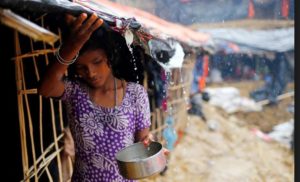Rohingya refugee families brace for monsoon
 Rohingya refugee families are reinforcing their shelters and digging drains in crowded camps in Bangladesh as the monsoon season opens.
Rohingya refugee families are reinforcing their shelters and digging drains in crowded camps in Bangladesh as the monsoon season opens.
Aid agencies say more than 40,000 Rohingya families in Bangladesh’s Cox’s Bazar refugee camps have now been trained in shelter upgrade techniques ahead of the fast approaching monsoon and cyclone season.
And women are playing a key role in the upgrade program being overseen by UN’s migration agency, the International Organisation for Migration (IOM).
With the first rains already affecting the camps, support workshops are continuing to be run by NGOs and aid agencies. The workshops show refugees how to best secure their shelters ahead of the strong winds and heavy rains expected later in May.
In total, 100,000 families will receive training, while IOM is overseeing the roll out of a similar number of upgrade kits containing ropes, bamboo, tarpaulin and tools.
At least 120,000 people are expected to be at grave risk of landslides and floods when the monsoon hits the steep sandy slopes of the Cox’s Bazar settlements, where almost a million Rohingya refugees are now living after fleeing violence in neighbouring Myanmar.
Dabal Rokaha, an IOM program officer overseeing the training, said the workshops had proved hugely popular with the refugee community, with the number of women taking part steadily increasing, until women regularly outnumbered men.
“Often their husbands are busy taking part in cash-for-work programs to improve ground conditions in the camps,” Ms Rokaha said.
“When we started the training there might be 20 men and 5 women, but now we often see 70 per cent female participation. The women are getting more confident. They will take ownership of what they learn and when they go back to their shelters, their husbands will listen to them and take their advice,” she said.
In addition to shelter upgrades, thousands of families at risk are also being relocated to safer ground. IOM says it is is working with World Food Program and UNHCR in the race to prepare more land for people to set up their shelters in safer locations less prone to flooding and landslides.
But despite the efforts underway, the topography of the camps and the expected weather conditions ahead means that mitigating against all disaster is near impossible. IOM is also training refugees in search and rescue and first aid.
IOM and its partners say they have been working with the Bangladesh authorities over the past months to create roads, pathways, bridges and drains, and to stabilize land, which will help keep vital access ways open during the rains.
Portering teams have also been created to bring in supplies on foot, if necessary. Distribution sites have been established in remote areas so that even if parts of the camp are cut off, people will still have access to aid.
But the cost of the operation has spiraled and IOM is now urgently appealing for additional funds and the cash shortfall is threatening the ability of aid agencies to respond to the inevitable emergencies that will arise during monsoon.
So far, just 7 per cent of the $US182 million funding appeal for the rest of the year has been secured.
The overall $US951 million Joint Response Plan for all agencies has secured just $US23 million.
Laurie Nowell
AMES Australia Senior Journalist












